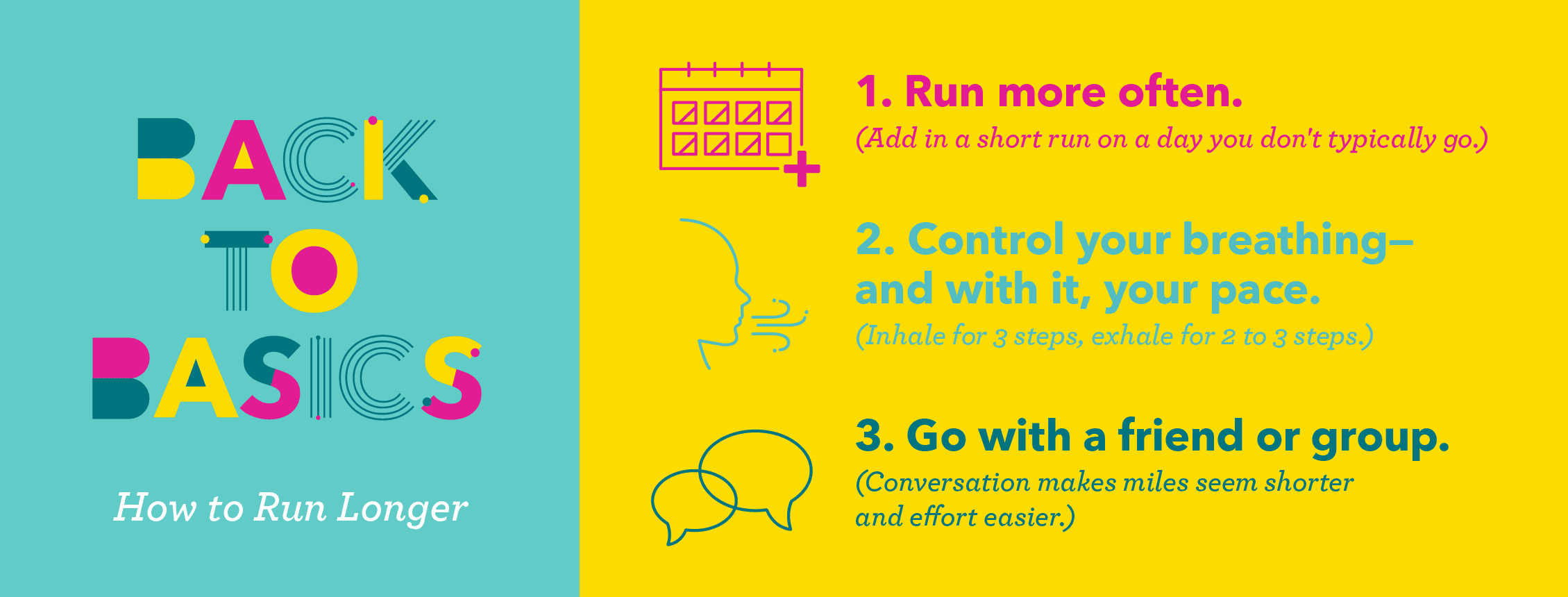
The long-distance run has a certain allure for a reason. Out there on a ribbon of a road, you’re floating along, getting it done, finding strength and insight in mile after mile. At the end, your legs carry that pleasant weariness all day long, reminding you of a job well done, while your mind feels more centered, less scattered.
You don’t need a double-digit run to unlock that post-run bliss, but, in our experience, you do need something a little longer than a two-miler. If you’ve been wondering how to get past 30 or so minutes of running—or how to increase your overall weekly mileage no matter where it is—here are some helpful tips on how to run longer.
#1: Run more often. Duh, right? But sometimes, we minimize the (large) benefits of adding on shorter runs. If you’re a three day a week runner, add a fourth day on. If you’re a regular with four days, add a fifth. The extra day should be very easy (more on that below), and be no longer than half of your longest run of the week. Translation: if your longest run is four miles, your extra day is no more than two.
#2: Add time to existing runs. Another no-brainer. Extend one or two runs a week by 10 minutes, 1 mile, something very doable that doesn’t disturb your schedule but still adds up. Sooner than you think, your regular three-miler will morph into your regular four-miler.
#3: But don’t get too greedy. The classic rule to avoid injury is to not increase your weekly mileage more than 10% per week, so do some math if your weekly mileage is less than 20 miles week; if you’re injury-prone, that means you’re tacking on no more than 2 total miles a week to start.
#4: Track your runs by minutes, not miles. The type-A streak present in most of us runners craves a .00 or .5 on our total distance in order to feel like a run is complete. But sometimes a full mile (or three) can be too much of a good thing. Changing the means of measurement can shift your perspective. Five extra minutes might net you another .43 miles; not super satisfying by itself, but if you end up tacking on 25 extra minutes over the course of a week, your mileage will tick up safely.
#4: Capitalize the E in Easy. If you’re focusing on how to run longer, focus exclusively on easy effort miles which build your cardiovascular base, which, in turn, helps you run longer.
You can check yourself a few ways:
1. The tried-and-true talk test. (Can you chat with a friend, sing out loud? If not, you’re going too hard.)
2. Your breathing pattern. Ideally, you’re aiming for a rhythmic breathing pattern that also—BOGO!—supports a mindful run. Take three steps (left, right, left) as you inhale, then either two or three steps as you exhale. (If you’re injury prone, check out this article which advocates for a 3:2 inhale/exhale pattern for easy runs.)
3. Take intentional walk breaks. Runners, especially those newer to the sport, tend to wait until they really need a walk break before taking one, which can wear you down both physically and mentally. Instead, decide that you’re going to take a one minute break every 5/10/15 minutes—whatever seems right to you based on your fitness, the weather, your energy level—and use that pattern from the start. You’ll parcel out your energy more evenly and keep your effort easy.
4. If you monitor your heart rate and know your zones, stay in zones 1-2 to make sure you’re not adding too much intensity.
#5: Join a group or recruit a friend. The momentum of companionship—and engaging conversation—is one of the best tools we know for both consistency and running longer. Just remember to keep your effort in check; if your friend is naturally more speedy than you, tell her you’re working on your endurance and want to be able to chat for all the miles.
#6: Eat. Any run over 75 minutes requires hydration and fuel during the run, so as your longer runs inch up towards that territory, be sure to have some calories on board. Zooming out, as your physical demands increase, give your body what it needs to thrive: plenty of protein, carbs that don’t come in a wrapper, nutritional fats like nuts and avocados, and plenty of vitamin-rich veggies. Your gas tank needs to be full of premium fuel if you’re adding in mileage.
[Not sure how to fuel correctly for longer races? Check out Nutrition for Running: Half Marathon + Marathon.]
#7: Strength Train. We’re not just talking about your quads here. As you run longer, your posture can wilt, your glutes can check out, your form can crumple. Including regular strength sessions that include moves for the backside of your body (like back extensions and hamstring curls); for your posture (planks galore!); and for glute engagement (single-leg exercises) will help you build the strength you need for the long runs that bring that bliss.
What did we miss? What tips do you have for how to run longer?






Running with a group of friends can make the miles fly by!
Thank you so much for including me – I’m so honored and excited to see my name on this list! This list is great for finding some new blogs to read also, which I always love :)
My recent post